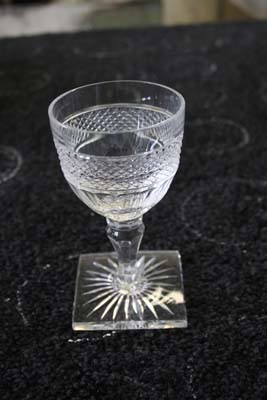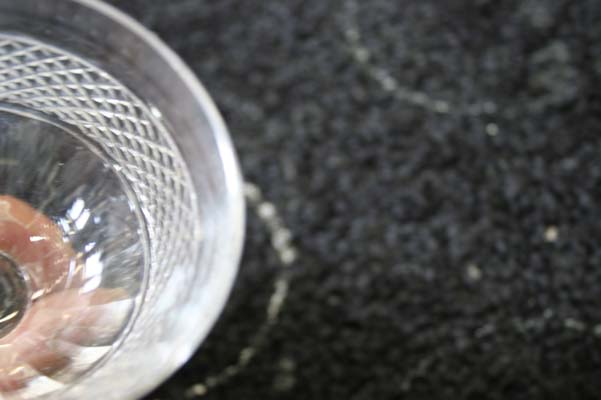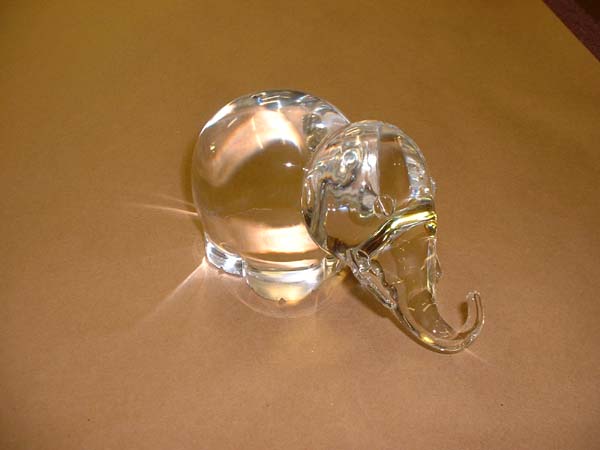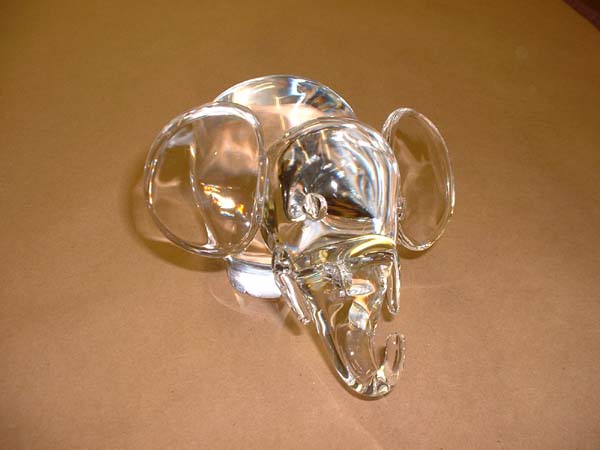Lalique Stemware Repair Project Repair Gallery
antique glass repair Hawkes chipped wine glass
Saturday, October 16th, 2010 Posted in All Repair Projects, Antique Glass Repair, Chipped Glassware, Chipped Stemware, Stemware Repair | Comments Off on antique glass repair Hawkes chipped wine glassAn antique Hawkes crystal wine glass was sent to me to be repaired. It had a chip on the rim . Hawkes cut crystal is one of the best cut glass companies of the American Brilliant Cut Glass area.

Antique cut glass Signed " Hawkes"
In 1880 Thomas G. Hawkes set up a cutting shop in Corning NY. He bought his fine handmade blanks from the Corning Glass Company. By 1886 the Hawkes Company was making glass for the White House In 1889 two of their cut glass patterns won the Grand Prize in the Paris Exposition. By the end of the nineteenth century the company was known for the best in cut glass. Even after the ware lost its general popularity, the Hawkes factory continued to produce cut glass of finest quality. Since all of their pieces were marked after 1895 (with two hawks), the new collector has easily identifiable glass in the Hawkes ware. A great deal of it has been made for special orders with monograms and even with crests. It offers a fascinating field to the collector who would like an historical collection of the patterns used by various presidents from 1886 to the present, or by well-known American families. Here is a type that has indeed been neglected.
From 1890, a period famous for cutglass, American factories produced a ware that differed appreciably from cut glass of the early 18oos. The glass itself was clearer due to finer ingredients and improved melting processes. Steam-run wheels made deeper cutting easier, although their use was not new to the period.
The thick lead glass, the handmade blanks, and the hours of skilled craftsmanship required for cutting decoration on blanks made this ware expensive. With today’s labor prices, the cost of producing tableware of this type would be prohibitive. The collectors who acquire this lovely crystal will have glass that will not be reproduced.
Although early Anglo-Irish glass was deeply cut, the patterns appearing after 1880 were more intricate and often completely covered pitchers, bowls, and candlesticks, even the rims and bases. The upper part of tumblers and necks of bottles were often the only clear areas, and even the latter were sometimes cut. The bases of most pieces had either a continuation of the pattern or a star. Like pressed glass, cut glass was made in sets for tableware. Articles such as chandeliers, candlesticks, candelabra, and vases were popular in early cut ware. By 1880 lamp shades and globes, complete lamps, and dresser sets were also made of cut glass.
“At no previous time have its uses been so many and its varieties so numerous. While the common glass is cheap beyond precedent, the finer glass, made from the best materials and highly wrought by hand, has exquisite beauties to which the world’s markets attach high values. It has the luminous brilliancy of colorless crystal, made by skillful cuttings to sparkle with white light or prismatic colors.” Thus one catalogue described its product.
Elaborate cut ware was beyond the reach of the majority, and therefore all the more desiw able. Factories making pressed glass soon foun” a substitute. Instead of selling plain blanks t the cutting shops, they pressed patterns into the blanks. Semiskilled cutters touched them up on the cutting wheel to make them almost perfect imitations of completely handmade articles. The short-cut method allowed a large supply to reach the market and as always happens when a scarce article becomes plentiful, cut glass no longer commanded so high a price. It was just a step to selling pressed blanks without the touching up on the cutter’s wheel, and then to making them of cheaper glass. “Near-cut” and “press-cut,” as the quantity productions were described, were advertised in mail-order catalogues as perfect imitations of popular cut ware.
By 1895 many factories were making this imitation cut glass. A decade later the deep cutting on hand-blown or machine-pressed blanks was rapidly going out of style. The market was so flooded with cheap imitation cut ware that by the time of World War I only a few cutting shops remained.
Until quite recently collectors of American glass have avoided cut ware because the early cut glass was considered to be Irish ware and the glass cut about 1900 not old enough to be considered an antique. For sometime, however, there has been a market for cut ware in the Southwest. Collecting either table sets (goblets, wines, sherbets, tumblers, plates, and odd pieces) or single decorative pieces, especially large fruit bowls, is becoming more and more popular everywhere. Those who start a collection now will be able to obtain a more complete set faster and more easily, and at a lower price, than in a few years.
The person who likes to collect one class of articles can choose small items such as knife rests, condiment sets, and the inevitable matchholders -hats, slippers, and boots. Cruets and cologne bottles are particularly lovely in cut glass, and powder boxes make very attractive candy containers. A punch bowl with the tray and cups is an expensive but very desirable set.
For the collector who wishes rare or cabinet pieces there are presentation, commemorative, and other special-order articles. Such a one is the large St. Louis punch-bowl set cut for the Libby Exhibit at the World’s Fair in 1904.

Repaired Rim
Tags: Antique Crystal repair, Antique Glass Repair, Antique Glassware Repair, Antique Stemware Repair, Baccarat Stemware Repair, Broken Stem, Broken Stemware Repaired, Chipped Crystal Repair, Crystal Repair, Crystal Restoration, Glassware Repair, Lalique Stemware Repair, Orrefors Stemware Repair, Stemware repair, Steuben Stemware Repair, Waterford Stemware Repair
Crystal Repair Steuben Elephant new ears
Sunday, February 1st, 2009 Posted in All Repair Projects, Chipped Glass Repair, Glueings, Steuben Crystal, Steuben Crystal Repair | Comments Off on Crystal Repair Steuben Elephant new earsBroken many years ago and put in a box and forgotten. Then the internet and solution to the earless elephant . I formed two ears out of a broken Steuben plate. This type of repair is fun know one would ever know the elephant had a ear job. Steuben glass figurine repair
Tags: Antique Crystal repair, Antique Glass Repair, Baccarat Stemware Repair, Blowen Glass Figurine Repair, Broken Glass Glued, Chipped Crystal Repair, Crystal Figurine Repair, Crystal Restoration, Glass Figurine Repair, Glassware Repair, Lalique Stemware Repair, Orrefors Stemware Repair, Stemware repair, Steuben Crystal, Steuben Stemware Repair, Waterford Stemware Repair


